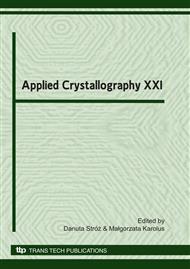p.118
p.123
p.127
p.131
p.137
p.141
p.145
p.151
p.157
Studies of NiTi Shape Memory Alloy after Severe Plastic Deformation
Abstract:
The results presented here concern the NiTi alloy subjected to plastic deformation by compression combined with reversion oscillating torsion. The compression rate was 0.05 mm/s and the torsion frequency and angle were 1Hz and ± 3o, respectively. The maximal strain obtained was c = 6.20. The structure of the deformed samples was studied with the use of X-ray phase analysis and TEM observations. It was found that the structure consists of a mixture of highly deformed B2 parent phase and B19’ martensite. The strain distribution after the applied plastic deformation was not uniform, the highest strain region was in the middle of the cylinder sample. In these regions small amount of the Ni2Ti phase was indentified. The TEM studies revealed some amorphous areas in the most strained region of the samples.
Info:
Periodical:
Pages:
137-140
Citation:
Online since:
June 2010
Authors:
Price:
Сopyright:
© 2010 Trans Tech Publications Ltd. All Rights Reserved
Share:
Citation:


